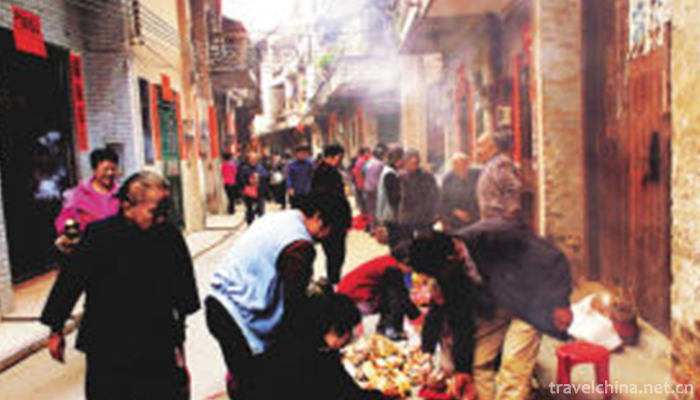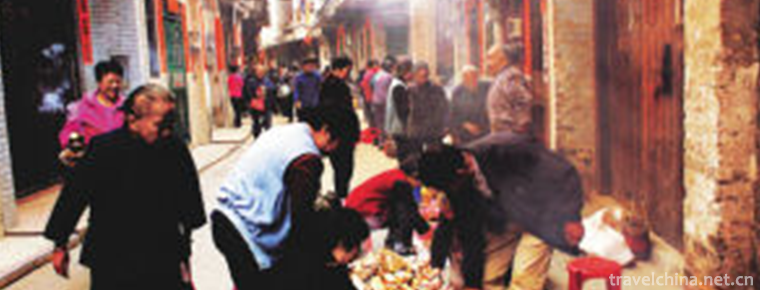Liaobu fragrant Market
Liaobu fragrant Market
Liaobuxiang City is a traditional folk activity. During the Wanli period of Ming Dynasty, the scent of Guanxiang perfumed over Liaobu Town in Dongguan every day. Numerous guanxiangs were transported from Dongguan to Hong Kong, and then dispersed from Hong Kong to Southeast Asia and even other countries in the world. As a result, Guanxiang and tea, ceramics and other valuable goods were exported overseas in the same period.
In December 2014, Liaobuxiang City, declared by Dongguan City, Guangdong Province, was listed in the fourth batch of national intangible cultural heritage list with the approval of the State Council.
Liaobuxiang City began in Song Dynasty, flourished in Ming Dynasty and Xiaosuo in late Qing Dynasty. During the Ming and Qing Dynasties, the well-known "Guanxiang" was distributed in Guangzhou and Hong Kong, which were exported to Southeast Asia and West Asia, so it was known as "fragrant city" and was known as one of the four famous cities in Guangdong.
Guanxiang was sold at home and abroad in Yuan, Ming and Qing dynasties, and Liaobu wharf was the main distribution center for export of Guanxiang. Hanxi River, which has a long history, has become an important place for commercial ports on the sea. Every December, businessmen from all over the country come to buy Guanxiang from Shannon. They fill the Liaobu wharf with wooden boats and boats, and then transport it to Shipaiwan (now Hong Kong Island) wharf through Dongjiangkou. On Shipaiwan wharf, businessmen pack and process Guanxiang and transport it to Guangzhou, Suhang, Jingshi, as far as Nanyang, Japan and Arabia.
historical origin
Historian Luo Xianglin textually studies the name of "Hong Kong" because it is a port for fragrance traffickers. Qu Dajun's "Guangdong Xinyu" describes the grand occasion of Guanxiang trading: "When Guanxiang is in full swing, it sells more than ten thousand gold at the end of the year... Therefore, most people in Guanguan start from fragrance." It can be seen that trade flourished at that time.
During the reign of Tang Zhenguan 1360 years ago, Lao was built step by step, and the ancestors lived in Mao Liao on the Bank of the tributary of the middle reaches of Hanxi River, hence their name. The soil and climate in this area are especially suitable for the growth of sweet gum trees. The spices produced are of the best quality. They have the fragrance of a mixture of amalus (from whale) and sandalwood, which blend the essence of animals and plants in two circles, and cross the barriers between the sea and the land. During the Ming and Qing Dynasties, the well-known "Guanxiang" was distributed here, transported by Hanxi River to Hong Kong, and exported to Jiangsu, Zhejiang, Beijing and Southeast Asia. During the Wanli period of Ming Dynasty, the scent of Guanxiang perfumed over Liaobu Town in Dongguan every day. Numerous guanxiangs were transported from Dongguan to Hong Kong, and then dispersed from Hong Kong to Southeast Asia and even other countries in the world. As a result, Guanxiang and tea, ceramics and other valuable goods were exported overseas in the same period.
Historian Luo Xianglin textually studies the name of "Hong Kong" because it is a port for fragrance traffickers. Qu Dajun's "Guangdong Xinyu" describes the grand occasion of Guanxiang trading: "When Guanxiang is in full swing, it sells more than ten thousand gold at the end of the year... Therefore, most people in Guanguan start from fragrance." "There are four cities in East Guangdong, one day fragrant city in Liaobu, where all the ripe products of Fanguanxiang gather."
Therefore, the well-known Liaobuxiang City, together with Guangzhou Flower Market, Lianzhou Pearl City and Luofu Pharmaceutical City, is known all over the world as the "four famous cities". The city of Liaobuxiang fell into a downturn in the middle and late Qing Dynasty.
At that time, corrupt officials still ravaged Shannon wantonly, coupled with years of war, turmoil, the sharp decline of Shannon and other reasons, the production of Guanxiang stalled, the trade of Lao-bu Xiangshi lost its former liveliness, the prosperous four cities in Guangdong gradually declined. But the culture of Guanxiang still lingers in Liaobu Town.
In 2009, Liaobu Town launched the "Ancient Fragrant City, Modern Fragrant Capital" Guanxiang Cultural Project, vigorously integrating historical and cultural resources, making great efforts, high starting point, high-level planning Fragrant City Cultural Tourism Project, creating "one district and six gardens" Fragrant City Tourist Area, gathering the natural fragrance and cultural flavor of Guanxiang, accelerating the pace of tourism development of Liaobu Town, and reappearing the lost fragrant city again. In the eyes of the world.
Therefore, the well-known Liaobuxiang City, together with Guangzhou Flower Market and Lianzhou Pearl City, is also known as the "Four Famous Cities" in the world.
Inheritance status
As a whole planning project, the government of Liaobu Town officially launched the Guanxiang Culture Project named "Ancient Xiangcheng City, Modern Xiangdu", which includes eight fragrant sub-projects, beginning with the establishment of the positioning of "Modern Green Xinxiang City". The project is called "Ancient Xiangcheng City, Modern Xiangdu". As a whole planning project, the "Modern Xiangdu" includes eight fragrant sub-projects:
Build a theme park in Xiangshi. The Laobu government plans to merge several parks in the region into Xiangshi Park. The park will be replanted with Guanxiang trees, build the symbolic buildings of Xiangshi, and integrate the cultural and leisure functions of the city. The architecture in the park mainly imitates Lingnan architecture of Ming and Qing Dynasties, emphasizing the incense city culture.
Build a cultural museum in Xiangshi. This museum is located as the first outdoor "living" town history museum in the Pearl River Delta. It reproduces the history of Xiangshi City through words, pictures, miniature models, projections, etc. It introduces the cultivation of Guanxiang, the origin of Xiangshi City, the use of perfumery and other aspects of fragrance culture.
Build a ten-mile fragrant dyke. Around the three embankments of the southwest river, the Laobu River and the Huangsha river of Liaobu town, the water conservancy project and the greening landscape project, through the cultivation of sweet trees, landscape construction and atmosphere building in Guan, create a 25 kilometer long "Xiangshi" green corridor, providing a good environment for tourists to feel the fragrant city and to be close to nature.
Restoration of an ancient street in Xiangshi. As the physical carrier of the provincial intangible cultural heritage of "Liaobuxiang City", the restoration and transformation of Yaxiang Street is an important part of the cultural process of reviving Xiangzhou City. Liaobu Town has begun to choose Jiefang West Road and Wanlong Street as the theme of restoring the style of the ancient street, and carry out restoration and reconstruction according to Lingnan architectural style of Ming and Qing Dynasties.
Knowledge expansion
Canton sweet tree
Wang Keyuan, a famous Chinese pharmacist in Guangdong, has studied deeply about Wan Xiang. The result of his research is that the soil and climate in Dongguan area are especially suitable for the growth of Canton sweet tree. The spices produced are of the best quality. The fragrance of a kind of amalus (from the sperm whale) and sandalwood mixed with the essence of the two circles of animals and plants has crossed the sea and land barriers. And the fragrance in the fragrance, let a person give birth to infinite reverie fragrance, is that today has been difficult to see "daughter fragrance". Legend has it that most of the girls who collect and make Guanxiang hide the best fragrant fragrances in their breasts and sell them at a high price in exchange for fat powder. Over time, there will be "Dongguan Daughter Fragrance" in the world.


-
1.Tianlong Tunpu
Tianlong Tunpu Town is located in Pingba District, Anshun City, western Guizhou Province. Deep in the mountains of karst landform, Tiantai Mountain and Longan Mountain are two mountains
Time 2019-02-21 -
2.Cloth tiger
Cloth tiger is a kind of traditional handicraft which has been widely spread among Chinese people in ancient times. It is also a good toy for children, indoor decoration
Time 2019-04-04 -
3.Tea Picking Opera
Tea-picking opera is a kind of traditional opera popular in Jiangnan and Lingnan provinces. It was mostly produced from the middle of Qing Dynasty to the end of Qing Dynasty.
Time 2019-04-04 -
4.Hu Yiyang Legend
Hu Yiyang (about 1639-1718) is a good prime minister. He is a native of Liuting Village, Renhua Township, Moxian County (now Liuting Street, Chengyang District, Qingdao City).
Time 2019-05-03 -
5.Legend of Mencius Mother and Godson
Legend of Meng Mu and Godson, Zoucheng local traditional folk literature, Shandong Province, one of the national intangible cultural heritage.
Time 2019-06-04 -
6.Wenshui Tiaozi
Wenshui Biaozi is an ancient and unique traditional folk music art spread in Wenshui County, Shanxi Province. It is named for its special copper cymbals commonly known as "Biaozi" in perform
Time 2019-06-29 -
7.Xibo Folk Songs
Xibo folk song is an important kind of traditional music culture of Xibo nationality, which is widely spread among the Xibo people in Chabchal Xibo Autonomous County and Xinjiang. Folk songs are an im
Time 2019-07-01 -
8.Printing Mud Making Skills
Lu'an Indian Mud is a traditional handicraft in Jing'an District of Shanghai. It was initiated by Zhang Lu'an. The process is complicated and the finished product is kept for a long time. The printing
Time 2019-07-13 -
9.Beijing University of Chinese Medicine
Beijing University of Traditional Chinese Medicine is a national key university with traditional Chinese medicine as its main subject. It is directly under the management of the Ministry of Education.
Time 2019-09-22 -
10.Rongxian Giant Buddha
Located in the eastern suburb of Rongxian County, Sichuan Province, the Giant Buddha of Rongxian county is carved in the Tang Dynasty. It is a cliff carved statue of Sakyamuni, 36.67 meters high, 8.76 meters long, 12.67 meters wide, 12 meters high and 3.5 meters wide. It is the world's largest Sakyamuni Buddha (Modern Buddha).
Time 2020-10-15 -
11.Longchi National Forest Park
Longchi National Forest Park is located in Dujiangyan City, Sichuan Province. It is only 84 kilometers away from Chengdu and 30 kilometers away from Dujiangyan. It is one of the 20 key national forest parks in China.
Time 2020-11-05 -
12.Dazhous first industry
In 2019, the annual grain planting area of Dazhou city is 556900 hectares, an increase of 0.3% over the previous year. Among them, rice was 191500 ha, an increase of 0.2%; maize was 137500 ha, an increase of 0.9%; potato was 162000 ha, a decreas
Time 2020-12-20